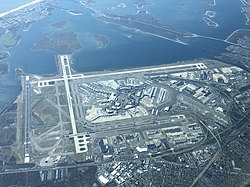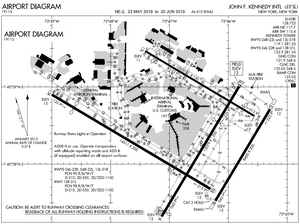
A | B | C | D | E | F | G | H | CH | I | J | K | L | M | N | O | P | Q | R | S | T | U | V | W | X | Y | Z | 0 | 1 | 2 | 3 | 4 | 5 | 6 | 7 | 8 | 9
John F. Kennedy International Airport | |||||||||||||||||||||||
|---|---|---|---|---|---|---|---|---|---|---|---|---|---|---|---|---|---|---|---|---|---|---|---|
 | |||||||||||||||||||||||
 Aerial view of John F. Kennedy International Airport in 2018 | |||||||||||||||||||||||
| Summary | |||||||||||||||||||||||
| Airport type | Public | ||||||||||||||||||||||
| Owner/Operator | Port Authority of New York and New Jersey[1] | ||||||||||||||||||||||
| Serves | New York metropolitan area | ||||||||||||||||||||||
| Location | Jamaica, Queens, New York City, New York, U.S. | ||||||||||||||||||||||
| Opened | July 1, 1948 | ||||||||||||||||||||||
| Hub for | |||||||||||||||||||||||
| Focus city for | |||||||||||||||||||||||
| Operating base for | Norse Atlantic Airways | ||||||||||||||||||||||
| Time zone | EST (UTC−05:00) | ||||||||||||||||||||||
| • Summer (DST) | EDT (UTC−04:00) | ||||||||||||||||||||||
| Elevation AMSL | 13 ft / 4 m | ||||||||||||||||||||||
| Coordinates | 40°38′23″N 73°46′44″W / 40.63972°N 73.77889°W | ||||||||||||||||||||||
| Website | www | ||||||||||||||||||||||
| Maps | |||||||||||||||||||||||
 FAA airport diagram as of 2019 | |||||||||||||||||||||||
 | |||||||||||||||||||||||
| Runways | |||||||||||||||||||||||
| |||||||||||||||||||||||
| Helipads | |||||||||||||||||||||||
| |||||||||||||||||||||||
| Statistics (2023) | |||||||||||||||||||||||
| |||||||||||||||||||||||
John F. Kennedy International Airport[a] (IATA: JFK, ICAO: KJFK, FAA LID: JFK) is a major international airport serving New York City and its metropolitan area, in the state of New York, United States. The airport is the busiest of the seven airports in the New York airport system, the 6th-busiest airport in the United States, and the busiest international air passenger gateway into North America.[5] The facility covers 5,200 acres (2,104 ha) and is the largest and busiest airport in the New York City area.[6]
Over 90 airlines operate from the airport, with nonstop or direct flights to destinations on all six inhabited continents.[7][8]
JFK is located in the Jamaica neighborhood of Queens,[9] 16 miles (26 km) southeast of Midtown Manhattan. The airport features five passenger terminals and four runways. It is primarily accessible via car, bus, shuttle, or other vehicle transit via the JFK Expressway or Interstate 678 (Van Wyck Expressway), or via train. JFK is a hub for American Airlines and Delta Air Lines as well as the primary operating base for JetBlue.[10]
JFK is also a former hub for Braniff, Eastern, Flying Tigers, National, Northeast, Northwest, Pan Am, Seaboard World, Tower Air, and TWA.
The facility opened in 1948 as New York International Airport[11][12][13] and was commonly known as Idlewild Airport.[14]
Following the assassination of John F. Kennedy in 1963, the airport was renamed John F. Kennedy International Airport as a tribute to the 35th President of the United States.[15][16][17]
History

JFK (1),
LaGuardia (2),
Newark (3)
airports
Construction
John F. Kennedy International Airport was originally called Idlewild Airport (IATA: IDL, ICAO: KIDL, FAA LID: IDL) after the Idlewild Beach Golf Course that it displaced. It was built to relieve LaGuardia Field, which had become overcrowded after its 1939 opening.[18]: 2 In late 1941, mayor Fiorello La Guardia announced that the city had tentatively chosen a large area of marshland on Jamaica Bay, which included the Idlewild Golf Course as well as a summer hotel and a landing strip called the Jamaica Sea-Airport, for a new airfield.[18]: 2 [19] Title to the land was conveyed to the city at the end of December 1941.[20] Construction began in 1943,[21] though the airport's final layout was not yet decided upon.[18]: 2–3
About US$60 million was initially spent with governmental funding, but only 1,000 acres (400 ha) of the Idlewild Golf Course site were earmarked for use.[22] The project was renamed Major General Alexander E. Anderson Airport in 1943 after a Queens resident who had commanded a Federalized National Guard unit in the southern United States and died in late 1942. The renaming was vetoed by Mayor La Guardia and reinstated by the New York City Council; in common usage, the airport was still called "Idlewild".[23] In 1944, the New York City Board of Estimate authorized the condemnation of another 1,350 acres (550 ha) for Idlewild.[24] The Port of New York Authority (now the Port Authority of New York and New Jersey) leased the Idlewild property from the City of New York in 1947[18]: 3 and maintains this lease today.[1] In March 1948, the City Council changed the official name to New York International Airport, Anderson Field, but the common name remained "Idlewild" until December 24, 1963.[16][25] The airport was intended as the world's largest and most efficient, with "no confusion and no congestion".[18]: 3 [26]
Early operations

The first flight from Idlewild was on July 1, 1948, with the opening ceremony attended by U.S. President Harry S. Truman and Governor of New York Thomas E. Dewey,[22][27] who were both running for president in that year's presidential election. The Port Authority canceled foreign airlines' permits to use LaGuardia, forcing them to move to Idlewild during the next couple of years.[28] Idlewild at the time had a single 79,280-square-foot (7,365 m2) terminal building;[18]: 3 by 1949, the terminal building was being expanded to 215,501 square feet (20,021 m2).[29] Further expansions would come in following years, including a control tower in 1952,[30] as well as new and expanded buildings and taxiways.[31][32]
Idlewild opened with six runways and a seventh under construction;[33] runways 1L and 7L were held in reserve and never came into use as runways. Runway 31R (originally 8,000 ft or 2,438 m) is still in use; runway 31L (originally 9,500 ft or 2,896 m) opened soon after the rest of the airport and is still in use; runway 1R closed in 1957 and runway 7R closed around 1966. Runway 4 (originally 8,000 ft, now runway 4L) opened June 1949 and runway 4R was added ten years later. A smaller runway 14/32 was built after runway 7R closed and was used until 1990[34] by general aviation, STOL, and smaller commuter flights.
The Avro Jetliner was the first jet airliner to land at Idlewild on April 16, 1950. A Sud Aviation Caravelle prototype was the next jet airliner to land at Idlewild, on May 2, 1957. Later in 1957, the USSR sought approval for two jet-powered Tupolev Tu-104 flights carrying diplomats to Idlewild; the Port Authority did not allow them, saying noise tests had to be done first. (The Caravelle had been tested at Paris.)
In 1951, the airport averaged 73 daily airline operations (takeoffs plus landings); the October 1951 Airline Guide shows nine domestic departures a day on National and Northwest. Much of Newark Airport's traffic shifted to Idlewild (which averaged 242 daily airline operations in 1952) when Newark was temporarily closed in February 1952 after a series of three plane crashes in the two preceding months in Elizabeth, all of which had fatalities; flights were shifted to Idlewild and La Guardia, which could have planes takeoff and land over the water, rather than over the densely populated areas surrounding Newark Airport.[35] The airport remained closed in Newark until November 1952, with new flight patterns that took planes away from Elizabeth.[36] L-1049 Constellations and DC-7s appeared between 1951 and 1953 and did not use LaGuardia for their first several years, bringing more traffic to Idlewild. The April 1957 Airline Guide cites a total of 1,283 departures a week, including about 250 from Eastern Air Lines, 150 from National Airlines and 130 from Pan American.[full citation needed]
Separate terminals
Zdroj:https://en.wikipedia.org?pojem=JFK_AirportText je dostupný za podmienok Creative Commons Attribution/Share-Alike License 3.0 Unported; prípadne za ďalších podmienok. Podrobnejšie informácie nájdete na stránke Podmienky použitia.
Antropológia
Aplikované vedy
Bibliometria
Dejiny vedy
Encyklopédie
Filozofia vedy
Forenzné vedy
Humanitné vedy
Knižničná veda
Kryogenika
Kryptológia
Kulturológia
Literárna veda
Medzidisciplinárne oblasti
Metódy kvantitatívnej analýzy
Metavedy
Metodika
Text je dostupný za podmienok Creative
Commons Attribution/Share-Alike License 3.0 Unported; prípadne za ďalších
podmienok.
Podrobnejšie informácie nájdete na stránke Podmienky
použitia.
www.astronomia.sk | www.biologia.sk | www.botanika.sk | www.dejiny.sk | www.economy.sk | www.elektrotechnika.sk | www.estetika.sk | www.farmakologia.sk | www.filozofia.sk | Fyzika | www.futurologia.sk | www.genetika.sk | www.chemia.sk | www.lingvistika.sk | www.politologia.sk | www.psychologia.sk | www.sexuologia.sk | www.sociologia.sk | www.veda.sk I www.zoologia.sk
